![]() 1st Battalion 22nd Infantry
1st Battalion 22nd Infantry ![]()
Memorial cannon for 22nd Commander found in the Philippines
Page Three - The New monument
On April 22, 2013, the new
monument to Harry C. Egbert was installed and inaugrated beside
the Social Hall
in the New Valenzuela City Hall Complex, city of Valenzuela,
Island of Luzon, Philippine Islands.
The new monument now
commemorates both Colonel Egbert and the Filipino soldiers who
fought
against him and the 22nd Infantry.
The following article describes the inauguration ceremony:
"Trivial, No more."
April 23, 2013
What was virtually regarded as
less important moment in Philippine history, “Labanan sa
Malinta" (Battle of Malinta),
will be given the prominence it deserves with the unveiling of a
historical marker from the National Historical Commission
of the Philippines (NHCP).
Formally turned over by NHCP to
the local government of Valenzuela yesterday, April 22, the
marker can be found inside
the New Valenzuela City Government Complex at Barangay Karuhatan,
where the battle approximately happened 114 years ago.
The Marker reads:
LABANAN SA MALINTA(Battle of Malinta)
26 MARSO 1899 (26 March 1899)
Naganap ang sagupaan ng mga sundalong Pilipino at Amerikano
hindi kalayuan sa simbahan ng Malinta, kung saan
napaslang ang ilang kawal ng 22nd U.S. Infantry kabilang si Col.
Harry C. Egbert, 26 Marso 1899. Bagaman nadepensahan
ng mga Pilipino sa unang bahagi ang kanilang posisyon sa Malinta,
kalauna’y napilitan silang umatras pahilaga sa
paglusob ng dagdag na kawal ng puwersang Amerikano. (The
battle between Filipino and American soldiers took place
near the church of Malinta, where some soldiers of the 22nd US
Infantry died, including Col. Harry C. Egbert, 26 March 1899.
Though the Filipinos were able to defend their position in
Malinta during the first half of the battle, they were later
forced to
retreat to the north as American reinforcement encroached.)
Malinta used to be a vast hacienda which stretched to as far as
parts of Novaliches, which also used to be part of the old Polo
(now Valenzuela City). The American forces must pass through
Malinta before they could advance to the town proper of Polo
where the Filipino military troops’ command center was led
by its Director de Guerra, Gen. Antonio Luna. It was, therefore,
necessary to seize it first. But the Filipino revolutionary
forces, which, in all likelihood, may have included some
Valenzuelanos,
did not yield so easily.
It was a battle they have clearly won. Local historian, Jerry
Gracio wrote on his paper, "Ang totoo, nakubkob ng mga
Amerikano
ang Malinta, pero hindi nila natalo ang mga Filipino sa
labang ito. (The Americans may have seized Malinta, but they
did not
defeat the Filipinos in this battle.)
According to Philippine historical accounts and supported by
American historical archives, during the battle on March 25,
1899,
the Filipinos erected large poles bearing flags as markers to
determine the exact range of advancing American troops. And when
they were approximately at 200 yards away, the Philippine
revolutionary forces fired at them, a tactic, regarded by some
American
documents as “accurate.” Many were killed among the
Americans, including the commander of the 22nd Infantry of the
United States Army, Colonel Harry Clay Egbert.
NHCP Executive Director, Ludovico Badoy said during the unveiling
that the Filipinos were merely forced to retreat because
of the Americans sent more reinforcement.
American war historian Marcus Wright described how the Filipinos
fled. “…dividing up, after the manner of the Indians,
so that they could not be successfully pursued.”
Years after the ”Battle of Malinta,” the Americans
placed four cannons to honor their comrades. However, only the
cannons
survives to this day - the one in honor of Col. Egbert. Since its
excavation in September 2012 at Dulong Tangke in Barangay
Malinta,
the 10-foot, 14-ton piece of artillery has been restored by the
city government with assistance from NHCP.
It is now on display beside the marker.
In 2011, the City Council passed Ordinance No. 30, recognizing
“Battle of Malinta Day,” a notable point in the history
of Valenzuela City and a celebration of the heroism of its
people.
As Ms. Gina Batuhan, Chief of the Historical Sites and Education
Division of the NHCP, said, “Historical markers are the
people’s
constant reminder of the Filipinos’ acts of heroism.”
With an official historical marker now in place, it shall become
a solid reminder
of the valor of the nameless Filipino and Valenzuelano heroes of
the "Battle of Malinta”.
The NHCP is the government agency that identifies and recognizes
historical sites.
This is the second historical marker placed by the agency in
Valenzuela City. The first one is located outside the house
of the revolutionary hero and the City’s namesake, Dr. Pio
Valenzuela.
From the Official Website of the City Government of Valenzuela
Photos from the Dedication Ceremony
Captions by the 1st Battalion website editor
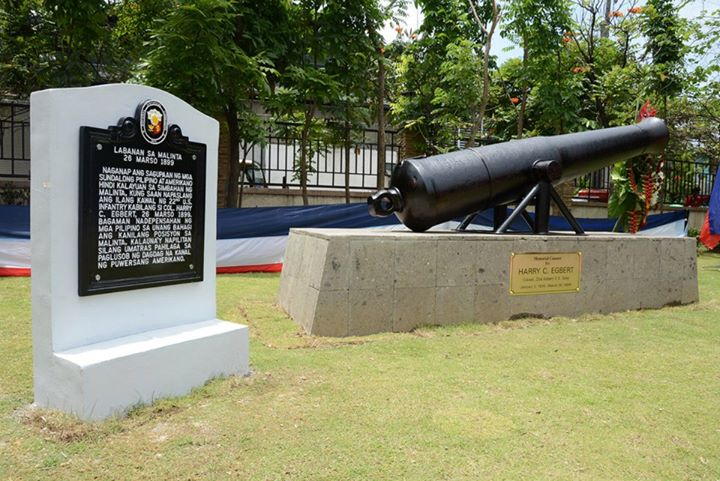
The Col. Harry C. Egbert memorial
cannon, and the historical marker for the Battle of Malinta in
1899
during the Filipino-American War, were inaugurated by the city
government of Valenzuela and the National
Historical Commission of the Philippines at the city hall
grounds, Valenzuela, April 22, 2013.
Photo by JONATHAN LICUAN/VALENZUELA CITY PIO

The Honor Guard stands in ceremonial "guard" of the monument.
Photo from the Museo Valenzuela website
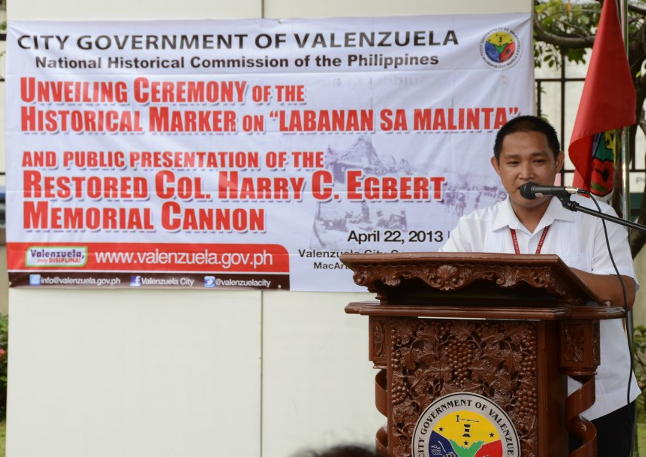
Jonathan Balsamo, curator of the Museo
Valenzuela, gives an address
at the dedication of the monument.
Photo from the Museo Valenzuela website
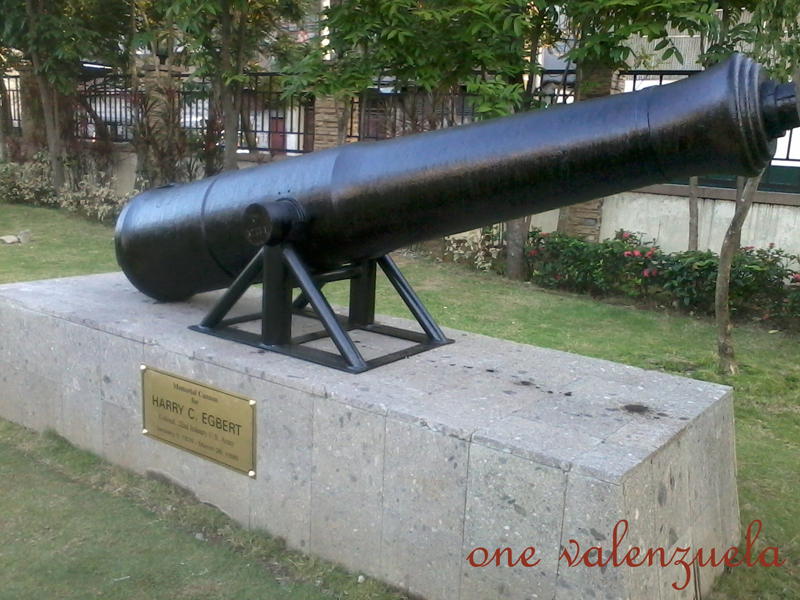
The original cannon memorializing
Colonel Harry C. Egbert,
in its new location.
Photo from the One Valenzuela website
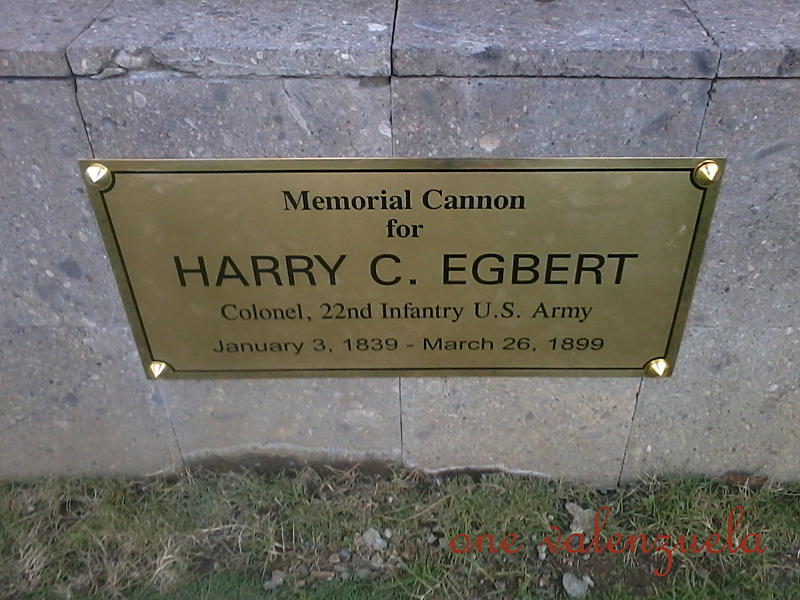
The plaque on the monument.
Photo from the One Valenzuela website

The historical marker commemorating the Battle of Malinta.
English Translation: Battle of Malinta
(26 March 1899) The battle happened between Filipino and American
soldiers not far from the church
of Malinta. Some of the soldiers from the 22nd U.S. Infantry
Brigade, including Col. Harry C. Egbert, were slain on 26 March
1899. Although the
Filipinos in Malinta have maintained their defense on the first
part of the battle, they have to eventually move north because of
the increase in
number of the American soldiers.
Translation from the One Valenzuela website
Photo from the One Valenzuela website
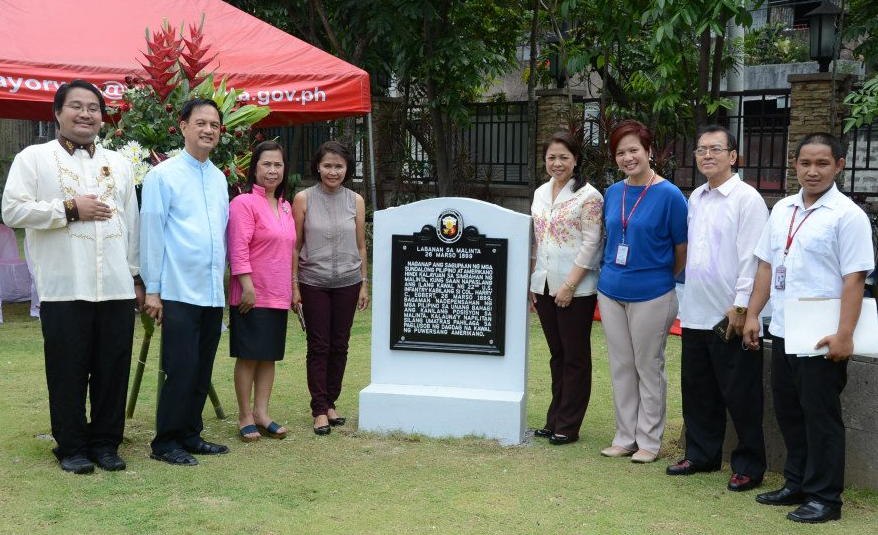
Dignitaries at the ceremony dedicating
the monument.
Curator Jonathan Balsamo is on the far right.
Photo from the Museo Valenzuela website
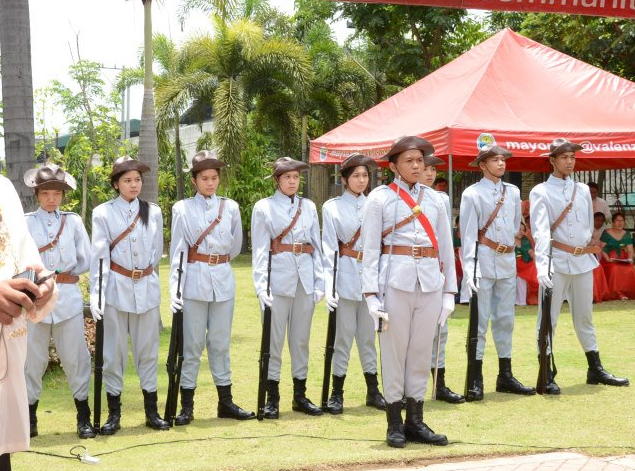
The Honor Guard ready for the ceremony.
Photo by JONATHAN LICUAN/VALENZUELA CITY PIO
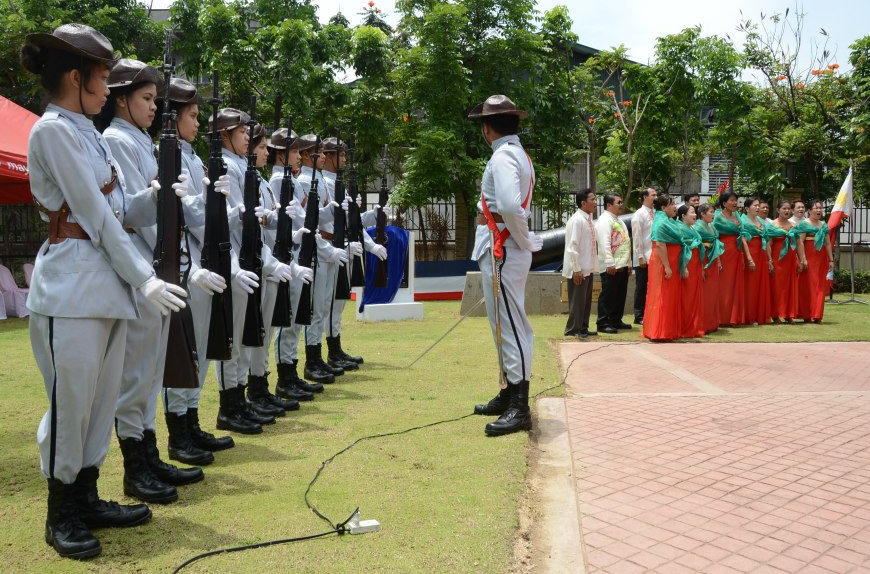
The Honor Guard salutes as the Philippine National Anthem is sung by a choir.
Photo from the Museo Valenzuela website
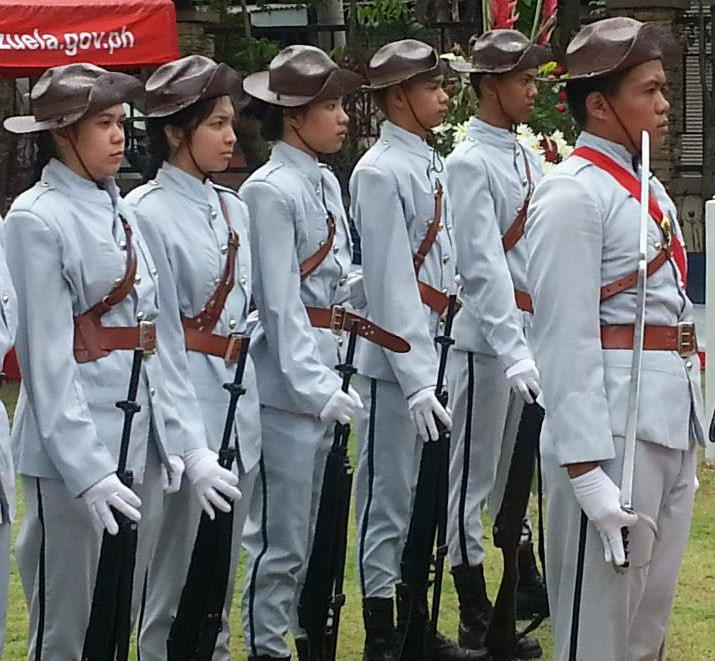
The Honor Guard, under command of their
officer, stands at parade rest.
The uniforms represent the uniforms worn by the first Filipino
National Army, 1899-1902.
Photo from the Museo Valenzuela website
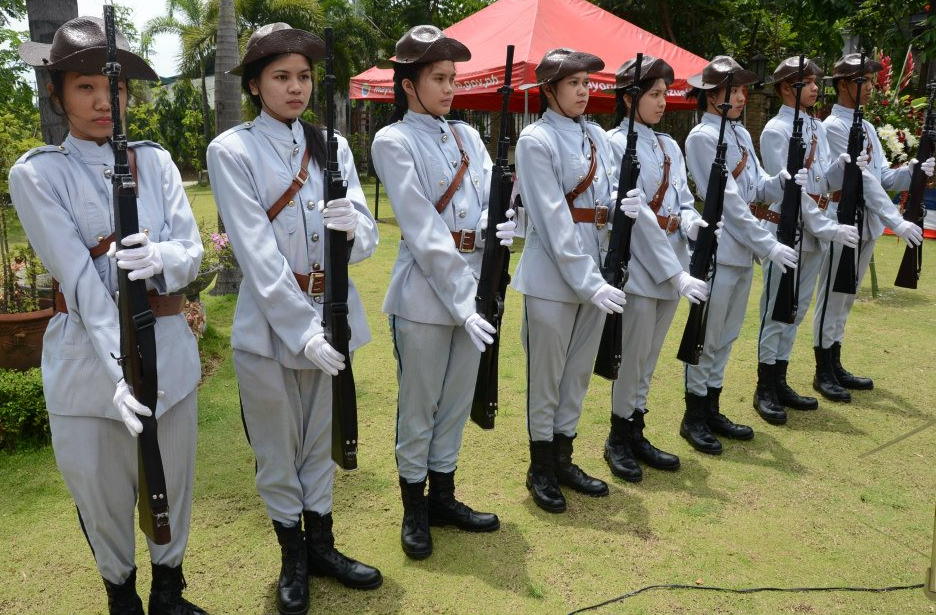
The Honor Guard presents arms during
the ceremony.
The rifles are surplus U.S. M-14 rifles which appear to be
de-activated and used as parade rifles.
Photo from the Museo Valenzuela website
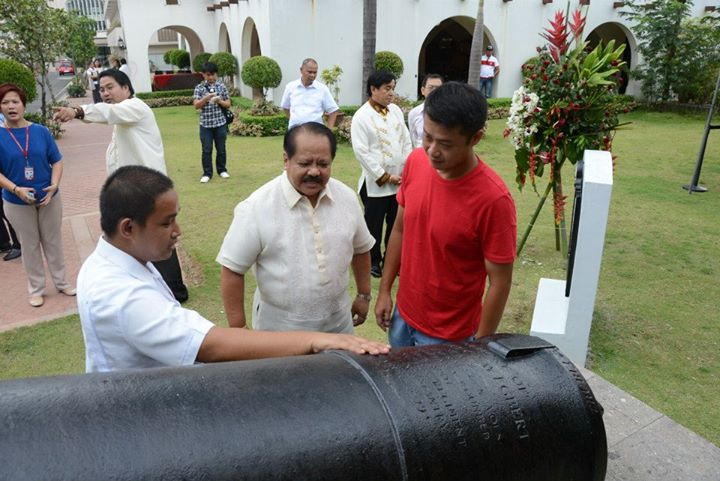
Curator of the Museo Valenzuela
Jonathan Balsamo discusses the cannon with a
dignitary and visitor.
Photo from the Museo Valenzuela website

A visitor compares the restored cannon
with a photo of the cannon, as it was found
in a basketball court/playground.
Photo by JONATHAN LICUAN/VALENZUELA CITY PIO
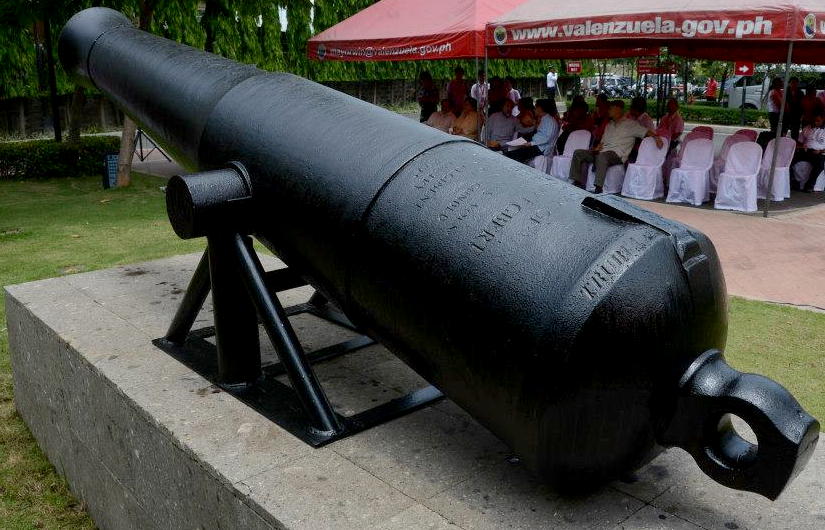
The restored cannon, rescued and preserved.
Photo from the Museo Valenzuela website
Home | Photos | Battles & History | Current |
Rosters & Reports | Medal of Honor | Killed
in Action |
Personnel Locator | Commanders | Station
List | Campaigns |
Honors | Insignia & Memorabilia | 4-42
Artillery | Taps |
What's New | Editorial | Links |